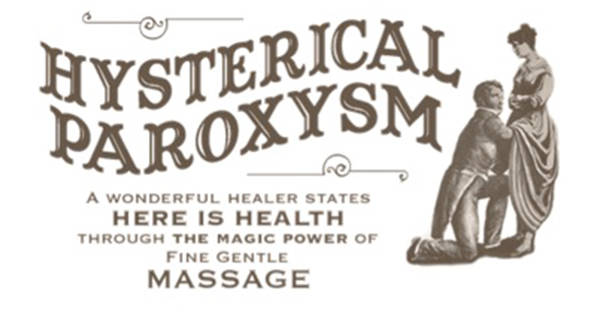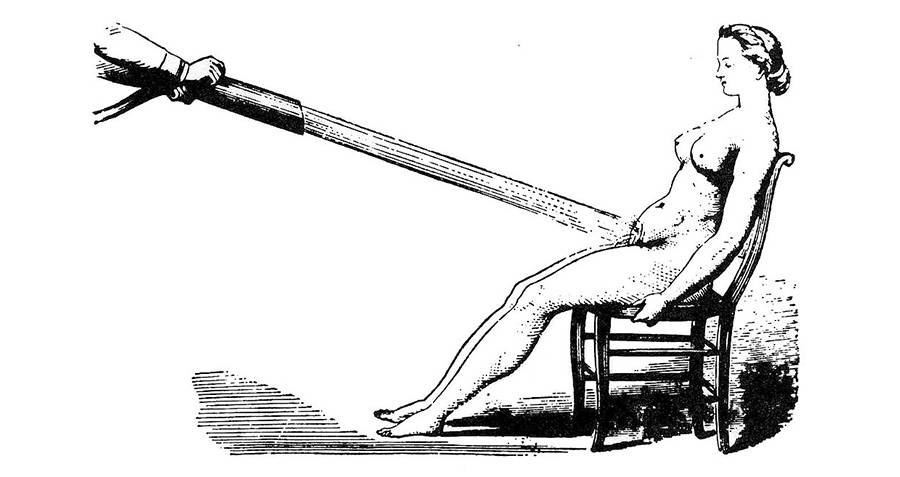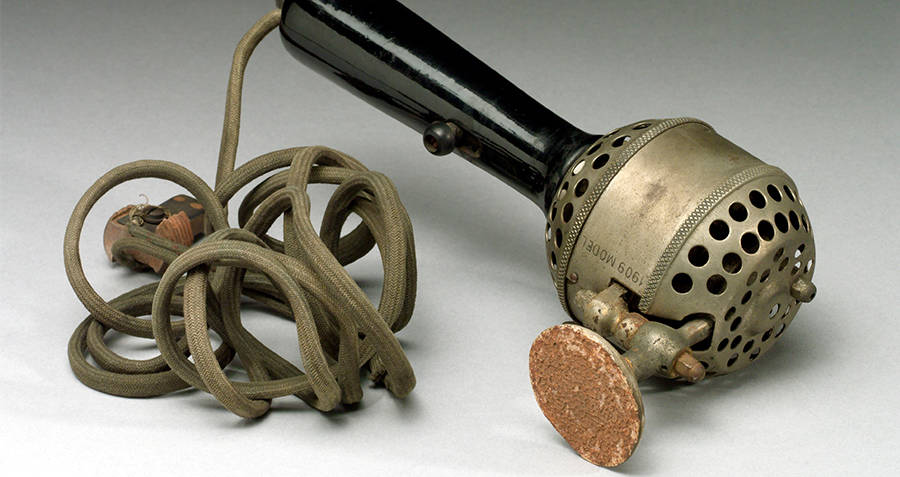By the 1800s women were increasingly diagnosed with hysteria, the treatment for which was a hysterical paroxysm. Today, we call that an orgasm.

Fun fact: The vibrator was the fifth household appliance to become electrified. It came out just after the electric toaster and had the vacuum cleaner beat by about 100 years.
Fitting, when you consider the fact that in the late 1800s, getting women off was a higher priority than having a clean floor. After all, if the women were left to stew in their sexual desires for too long, who knows what could have happened?
Obviously, the truth is nothing. Sure, she’d probably be crabby for a few days, but as we know today, nothing would have happened, as women are perfectly capable of controlling themselves.
However, as far as the Victorian medical community, psychiatric community, and several behavioral scientists (ironically, all of whom were composed of men) were concerned, a sexually frustrated woman needed to be attended to immediately, lest her womb wander and her mind be overcome by the dreaded female hysteria.
Female hysteria is the now-defunct term used to diagnose a woman who suffered from any variety of ailments. Symptoms included anything from fainting to erotic fantasies, to a loss of appetite, to “a tendency to cause trouble.” Basically, anything that couldn’t be directly attributed to something else fell under the “female hysteria” umbrella.
The History Of Diagnosing Female Hysteria
The first scientist to describe female hysteria – though without a cure – was Hippocrates.
In his ancient medical texts, written all the way back in 500 B.C., Hippocrates suggested that a variety of ailments that seem to affect females instead of males could be traced back to the womb – the most inherently female body part. Hippocrates believed that the womb was a free-floating, wandering animal. When it moved into an unexpected place or too close to another organ, problems would arise.
Later, from his teachings, the word “hysteria” surfaced, stemming from the Greek word for uterus – “hystera.”

Wikimedia CommonsHippocrates and Galen.
A few hundred years later, a Roman physician named Galen theorized that this hysteria, this movement of the womb, was caused by sexual deprivation. Women who were married had an easy fix – simply enlisting their husbands to help them out. However, for unmarried women, widows, and those who were devoted to the church, things weren’t so easy.
Therefore, Galen proposed the groundbreaking idea of pelvic massage. The result of the massage brought on the intended cure, a “hysterical paroxysm.”
That is, an orgasm. Specifically, a good orgasm.
In his notes, he wrote a detailed description of the technique and its desired results:
“Following the remedies and arising from the touch of the genital organs required by the treatment, there followed twitchings accompanied at the same time by pain and pleasure after which she emitted turbid and abundant sperm. From that time on she was free of all the evil she felt.”
From then on, medical professionals would cite his technique, one that would be used without much change for hundreds of years. Through almost every century leading up to the hysteria boom of the 1800s, manual sexual relief of women was mentioned in medical journals and home health guides as a diagnosis of hysteria became more widespread.

Wikimedia CommonsA woman receiving hydrotherapy.
In 1660, the term “orgasm” was first coined by Dr. Nathaniel Highmore to describe the end result of a pelvic massage. Highmore, being a smart man, also pointed out that achieving this desired end result was no easy task, equating it to “that game of boys in which they try to rub their stomachs with one hand and pat their heads with the other.”
By the 1800s, hysteria was widely accepted as the most common disease amongst women and one that doctors found themselves treating with increasing frequency. In fact, a French physician named Pierre Briquet made the bold claim that at least a quarter of all women in the Victorian era suffered from “hysteroneurasthenic disorders.”
Automating The “Cure” For Female Hysteria
However, since they’d been doing it for several centuries, doctors were beginning to tire of the old method described by Galen. Literally, they were “paroxysing” so many women that their fingers had begun to cramp, and they started to look for alternative methods.
The first method was hydrotherapy. Women would sit in a specially designed chair and have a powerful jet of water directed at their pelvic region. One doctor claimed that there was no better way to administer a paroxysm and that the effects were “impossible to describe.”
However, soon enough another doctor decided that there was a better way, and came up with the Manipulator.
The Manipulator was a large, cumbersome table, with a hole in it, in which was placed a vibrating sphere atop which women would sit. Doctors were strongly advised against letting women sit atop the sphere for longer than a few minutes, as it could result in “overindulgence.”

Getty ImagesEarly example of an electric vibrator.
Slowly, vibrators began to get smaller, beginning with a portable version in 1882, which ran on a 40-pound battery and involved two separate units. The machine was highly recommended by medical professionals, as manual massages took “a painstaking hour to accomplish” and provided “much less profound results than are easily affected by [the vibrator] in a short five or ten minutes.”
By the early 1900s, the vibrator had become more portable, more affordable, and to many women’s delight, more private. With the advancement of technology, they were able to be electrified and therefore used at home. No longer did women have to seek the attention of a doctor, when they could simply remedy their sexual frustrations alone and in the comfort of their own homes.
Thankfully, over the years, the diagnosis of female hysteria has been left in the past. In 1950, the American Psychological Association dropped the term from their manual, the Diagnostic and Statistical Manual of Mental Disorders, and in 1980, they replaced it with “conversion disorder,” a disorder in which the symptoms can not reasonably be explained medically.
Unlike its controversial parentage, the vibrator stood the test of time, evolving through hundreds of iterations and eventually becoming what it is today, an item so common it’s sold on drugstore shelves.
After reading about the history of female hysteria and its treatments, check out the twisted history of female body modification practices from around the world. Then, take a look at the history of the chastity belt.




